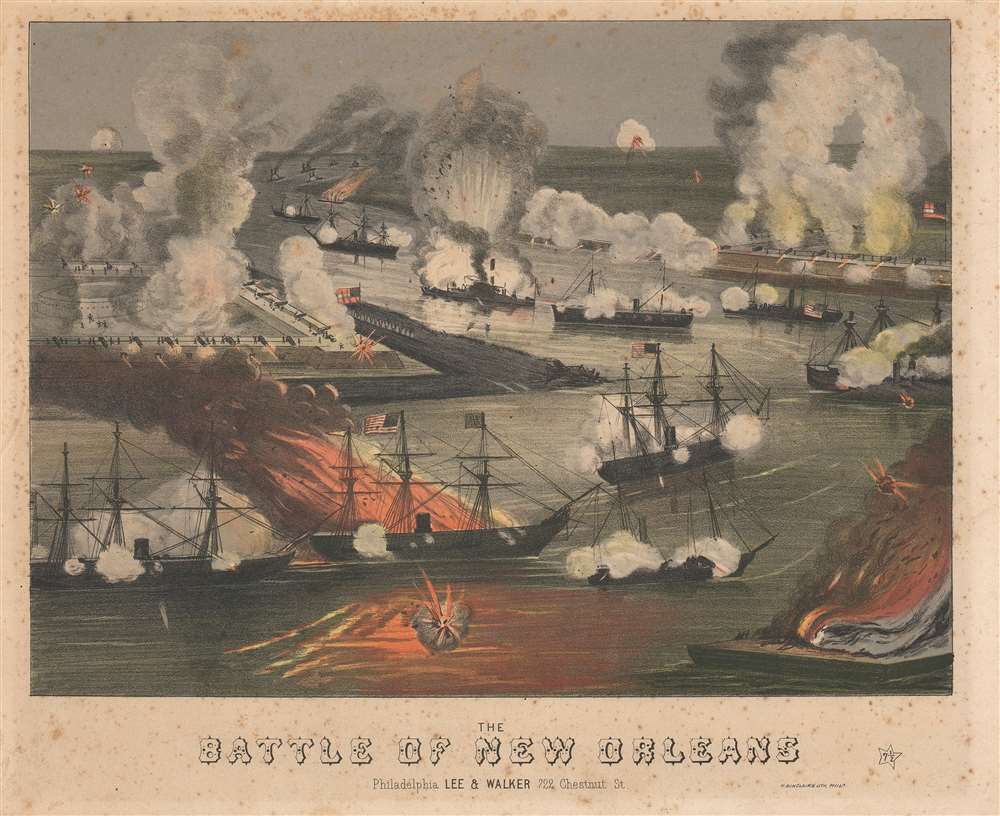This item has been sold, but you can get on the Waitlist to be notified if another example becomes available, or purchase a digital scan.
1862 Sinclair View of the U.S. Civil War Battle of Forts Jackson and St. Philip
BattleNewOrleans-sinclair-1862
Title
1862 (undated) 9.75 x 12 in (24.765 x 30.48 cm)
Description
The Battle of Forts Jackson and St. Philip
Following the successful Union attack on a land-based fort in the Battle of St. Royal, South Carolina, on November 7, 1861, Assistant Secretary of the Navy Gustavus V. Fox had been pushing for more naval actions against land-based forts and other installations. Fox was the first to propose a joint army-navy operation against New Orleans, then the largest city in the Confederacy. Union General-in-Chief George B. McClellan, however, opposed the idea, believing that it would distract from his Peninsula Campaign against Richmond. By February 1862, however, a political general by the name of Benjamin Butler was persuaded to support the mission. He was then put in command of the army meant to take the forts after the naval bombardment. The Battle of Forts Jackson and St. Philip took place from April 18, 1862 until April 28, 1862, when New Orleans was captured by the Union. From April 18th to the 23rd, twenty-one Union mortar schooners bombarded the forts in the belief that they would be able to completely annihilate them and save the rest of the flotilla from having to fire on the forts. In reality, however, this bombardment did little damage to either fort, but the aim of the defending Confederates was so poor that between the forts and the defending Confederate navy, the Union only lost one ship in the run between the forts, while the Confederates lost twelve.Census and Publication History
This view was created by Thomas S. Sinclair and published by Lee and Walker to accompany Charles Grobe's Op. 1412, The Battle of New Orleans, in 1862. The only known example in an institutional collection is in the Library of Congress.CartographerS
Lee and Walker (1848 - 1875) was a Philadelphia-based music publishing firm founded by George W. Lee (d. 1875) and Julius Walker (d. 1857). Lee and Walker had both worked as clerks in George Willig's publishing company before founding their own firm, and absorbed Willig's business in 1856. Walker died in 1857, but Lee maintained the firm and kept the name until 1875 when the firm was bought out by Oliver Ditson of Boston. More by this mapmaker...
Thomas S. Sinclair (c. 1805 - 1881) was an American lithographer. Born in the Orkney Islands, Scotland, Sinclair studied lithography in Edinburgh and other European cities before moving to the United States sometime before 1833. He was established in Philadelphia by 1833, when he drew a dancing scene for the firm of Kennedy and Lucas, which went out of business that same year. In 1838, Sinclair acquired the press of John Collins and opened his own lithography firm. He was among the first lithographers in Philadelphia to experiment with color lithography, beginning in 1843. By 1848, his skills ad advanced to such a degree that he won a silver medal for color lithography at the Franklin Institute's exhibition. Sinclair's brother, William B. Sinclair, joined the firm in 1854, and from that year until 1859 the establishment was known as Thomas Sinclair and Company. His son joined the company at one point also, and then the firm's name changed to Thomas Sinclair and Son. Sinclair died in Philadelphia in 1881. Learn More...

